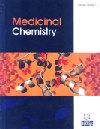揭示噁二唑衍生物的抗癌潜力:结构-活性关系和化学-生物学见解的全面探索
IF 2.6
4区 医学
Q3 CHEMISTRY, MEDICINAL
引用次数: 0
摘要
背景:噁二唑衍生物作为低μM药效的抗癌药物已显示出巨大的潜力。这类药物包括雷特格韦(Raltegravir)、齐博替坦(Zibotentan)、赛替鲁通(MK-0633)、奈沙吡地尔(Nesapidil)、呋喃唑酮(Furamizole)和替达唑嗪(Tidazosin)。Raltegravir 中的噁二唑核体现了其在药物开发中的重要性,展示了如何将噁二唑等特定结构基团战略性地融入分子中,以达到预期的治疗效果。全球已有大量研究人员开发并报道了许多噁二唑作为潜在的抗癌药物。目的:因此,我们试图讨论 2019 年至 2023 年间报道的噁二唑衍生物的抗癌潜力。必须确定潜在化合物在不同靶点上的设计策略、结构-活性关系(SAR)和蛋白质-抑制剂相互作用,以帮助药物化学家设计新的药物相似性噁二唑分子用于抗癌治疗。同样,还需要使用 SWISSADME 工具研究潜在噁二唑的 ADMET 特征。结果:我们重点介绍了最近报道的最有效的噁二唑衍生物及其混合化合物。SAR 研究表明,与噁二唑连接的吡啶、吲唑、噻二嗪、喹喔啉、噻唑烷、茚并吡唑、噻吩、哌啶、苯并咪唑、三唑和磺酰胺具有良好的抗癌作用。潜在噁二唑化合物的化学生物相互作用表明,它们与不同的氨基酸残基有良好的相互作用,因此可能成为开发新型有效抗癌疗法的候选化合物。同样,硅学 ADMET 报告表明,潜在的噁二唑化合物具有良好的物理化学、药代动力学和药物亲和性。结论总之,这些结果将被证明是药物化学家研究和使用噁二唑抗癌作用的有用和重要的工具。本文章由计算机程序翻译,如有差异,请以英文原文为准。
Unveiling the Anti-cancer Potential of Oxadiazole Derivatives: A Comprehensive Exploration of Structure-Activity Relationships and Chemico-Biological Insights
Background: Oxadiazole derivatives have shown significant potential as anti-cancer agents with low μM potencies. Some examples of drugs in this class include Raltegravir, Zibotentan, Setileuton (MK-0633), Nesapidil, Furamizole, and Tidazosin. The presence of the oxadiazole nucleus in Raltegravir exemplifies its importance in drug development, showcasing how specific structural motifs like oxadiazole can be strategically incorporated into molecules to achieve desired therapeutic effects. A large number of researchers across the globe have already developed and reported many oxadiazoles as potential anti-cancer medicines. Objective: Therefore, we tried to discuss the anti-cancer potentials of oxadiazole derivatives reported between 2019 and 2023. The design strategies, structure-activity relationship (SAR), and protein- inhibitor interactions of potential compounds on different targets have to be identified to help the medicinal chemists design new drug-likeness oxadiazole molecules for anti-cancer therapy. Similarly, the ADMET profiles of potential oxadiazoles using the in silico SWISSADME tool have to be studied. Results: We have highlighted the recently reported most potent oxadiazole derivatives as well as their hybrid compounds. The SAR study revealed that oxadiazole-linked pyridine, indazole, thiadiazine, quinoxaline, thiazolidine, indeno-pyrazole, thiophene, piperidine, benzimidazole, triazole, and sulphonamide showcased promising anti-cancer action. The chemico-biological interactions of potential oxadiazole compounds suggest good interactions with different amino acid residues that make them possible candidates for developing novel and effective anti-cancer therapies. Similarly, the in silico ADMET report suggested favourable physicochemical, pharmacokinetic, and druglikeness properties of potential oxadiazole compounds. Conclusion: Overall, these results will prove to be a helpful and vital tool for medicinal chemists investigating and working with oxadiazoles for anti-cancer action.
求助全文
通过发布文献求助,成功后即可免费获取论文全文。
去求助
来源期刊

Medicinal Chemistry
医学-医药化学
CiteScore
4.30
自引率
4.30%
发文量
109
审稿时长
12 months
期刊介绍:
Aims & Scope
Medicinal Chemistry a peer-reviewed journal, aims to cover all the latest outstanding developments in medicinal chemistry and rational drug design. The journal publishes original research, mini-review articles and guest edited thematic issues covering recent research and developments in the field. Articles are published rapidly by taking full advantage of Internet technology for both the submission and peer review of manuscripts. Medicinal Chemistry is an essential journal for all involved in drug design and discovery.
 求助内容:
求助内容: 应助结果提醒方式:
应助结果提醒方式:


